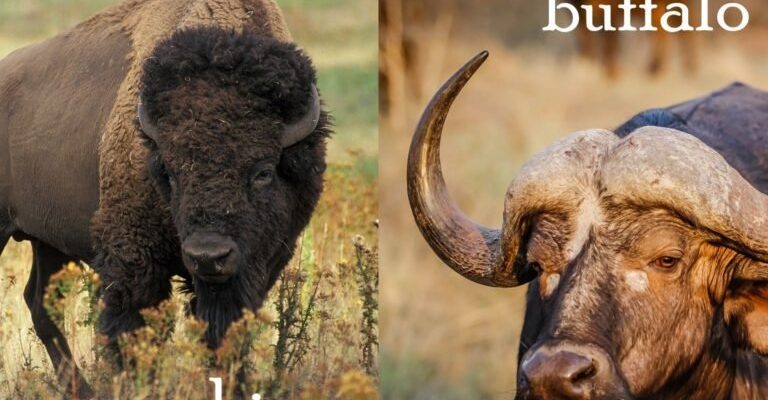![Comparing The American Bison Vs. [Similar Species]](https://gudri.com/wp-content/uploads/2025/06/Comparing_The_American_Bison_Vs___Similar_Species__image_0.jpg)
In this article, we’ll dig deep into the lives of the American and European bison, exploring their physical characteristics, habitats, diets, and behaviors. By the end, you’ll have a clear understanding of how these two giants compare and what makes each one special. So grab your coffee, settle in, and let’s embark on this journey!
Physical Characteristics: Size and Build
The first thing that might strike you about the American bison is its impressive size. Standing around 6 feet tall at the shoulder and weighing between 900 to 2,200 pounds, it’s no wonder why they are often referred to as “buffalo.” Their muscular build, coupled with a distinct hump on their backs, gives them a powerful appearance. When you see one, you can’t help but be amazed at their sheer bulk.
On the other hand, the European bison is slightly smaller, averaging around 5.5 to 6.5 feet at the shoulder and weighing between 1,100 to 2,200 pounds. They have a more elegant shape, with longer legs and a less pronounced hump. Their horned heads are also smaller than those of the American bison, giving them a different look. You might say that while the American bison is the bulky linebacker of the animal world, the European bison is more like a swift runner.
Habitat: Where They Roam
Now let’s talk about where these two bison make their homes. The American bison is known for its presence on the vast plains and grasslands of North America. They thrive in regions such as the Great Plains, Yellowstone National Park, and even in parts of Canada. Their favorite spots are open grasslands where they can graze on grasses, herbs, and shrubs.
In contrast, the European bison primarily occupies woodlands and deciduous forests across Europe, especially in places like Poland and Belarus. They prefer areas with a mix of trees and open spaces, allowing them to browse on leaves, bark, and various plant materials. You might think of the American bison as the open-fields explorer, while the European bison takes on the role of a forest-dweller, navigating the shadows of tall trees.
Diet: What They Eat
When it comes to their diets, both species are herbivores, but their food preferences vary based on their environments. The American bison enjoys a diet rich in grasses, and they are known for their ability to consume large amounts of forage. During the spring and summer, when food is abundant, they graze almost continuously, using their powerful tongues to pull grass from the ground.
Meanwhile, the European bison has a more varied diet that includes not just grasses, but also leaves and young shoots from trees. In the harsh winter months, when food is scarce, they might even strip bark from trees. Imagine these two bison at a buffet: the American bison focuses on the endless salad bar, while the European bison samples a bit of everything, enjoying some hearty greens and tree bark as a snack.
Behavior: Social Structures and Migrations
Both bison species display fascinating social behaviors, but they do so in different ways. American bison are highly social animals and tend to gather in large herds that can number in the thousands. These herds are usually composed of females and their young, while adult males roam independently or form small bachelor groups. During migration periods, they travel together in search of food and water, creating a magnificent sight as they thunder across the plains.
European bison, on the other hand, are generally less social. They often form smaller groups, usually around 10 to 20 individuals. These groups may consist of females and their young, while adult males prefer to be solitary or in smaller bachelor groups. Their social structure is less about large herds and more about family units, where they can communicate and bond in close quarters. You can picture the American bison as the life of the party, while the European bison enjoys a cozy gathering with family.
Conservation: Challenges and Efforts
Both the American and European bison have faced significant threats over the years. The American bison was nearly driven to extinction in the late 1800s due to overhunting and habitat loss. Fortunately, conservation efforts have led to significant population recovery, and today they are protected and can be found in national parks and reserves.
Conversely, the European bison has also faced challenges, primarily due to habitat destruction and hunting. However, through conservation programs and breeding efforts in reserves, their numbers are gradually increasing. It’s a heartwarming example of how human efforts can make a difference. You might find it inspiring to know that both species have dedicated advocates working tirelessly to ensure their survival.
In wrapping up our comparison, it’s clear that the American bison and European bison are remarkable in their own right. While they share a common lineage and some similarities, their adaptations to different environments have made them unique. Whether it’s the American bison’s commanding presence on the open plains or the European bison’s grace in the forests, both types of bison deserve our respect and admiration.
So, the next time you think about these magnificent creatures, remember the nuances that set them apart. It’s not just about their size or where they live; it’s a story of survival, adaptation, and the ongoing efforts to protect their legacies. In our fast-paced world, taking a moment to appreciate such differences reminds us of the natural beauty that surrounds us.

